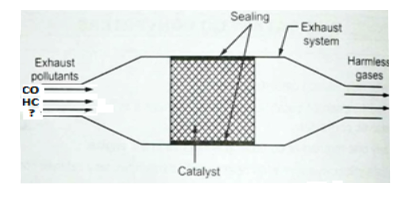As the exhaust passes through the catalytic converter, unburnt hydrocarbons are converted into carbon monoxide and water.
To solve the question regarding the conversion of unburnt hydrocarbons in a catalytic converter, we can break it down into the following steps:
Step 1: Understanding the Role of Catalytic Converters
- Catalytic converters are devices used in the exhaust systems of vehicles to reduce harmful emissions. They convert harmful gases produced during combustion into less harmful substances.
Step 2: Identifying the Harmful Emissions
- The primary harmful emissions from automobile exhaust include unburnt hydrocarbons (HC), carbon monoxide (CO), and nitrogen oxides (NOx). Unburnt hydrocarbons are particularly concerning as they contribute to air pollution and smog.
Step 3: The Conversion Process
- As exhaust gases pass through the catalytic converter, a chemical reaction occurs. The unburnt hydrocarbons are oxidized and converted into carbon dioxide (CO2) and water (H2O).
Step 4: Clarifying the Misconception
- It is important to note that while unburnt hydrocarbons are converted into carbon dioxide and water, carbon monoxide is also a product of incomplete combustion. However, in the context of the catalytic converter, the goal is to minimize harmful emissions, including CO.
Step 5: Conclusion
- The catalytic converter effectively reduces the amount of harmful gases released into the atmosphere by converting unburnt hydrocarbons into less harmful substances, primarily carbon dioxide and water.
Final Answer
- The unburnt hydrocarbons are converted into carbon dioxide (CO2) and water (H2O) as they pass through the catalytic converter, reducing the overall toxicity of the exhaust gases.
---
- Catalytic converters are devices used in the exhaust systems of vehicles to reduce harmful emissions. They convert harmful gases produced during combustion into less harmful substances.
- The primary harmful emissions from automobile exhaust include unburnt hydrocarbons (HC), carbon monoxide (CO), and nitrogen oxides (NOx). Unburnt hydrocarbons are particularly concerning as they contribute to air pollution and smog.
- As exhaust gases pass through the catalytic converter, a chemical reaction occurs. The unburnt hydrocarbons are oxidized and converted into carbon dioxide (CO2) and water (H2O).
- It is important to note that while unburnt hydrocarbons are converted into carbon dioxide and water, carbon monoxide is also a product of incomplete combustion. However, in the context of the catalytic converter, the goal is to minimize harmful emissions, including CO.
- The catalytic converter effectively reduces the amount of harmful gases released into the atmosphere by converting unburnt hydrocarbons into less harmful substances, primarily carbon dioxide and water.
- The unburnt hydrocarbons are converted into carbon dioxide (CO2) and water (H2O) as they pass through the catalytic converter, reducing the overall toxicity of the exhaust gases.
Topper's Solved these Questions
- ENVIRONMENTAL ISSUESBOOK - AAKASH INSTITUTE ENGLISHCHAPTER - ENVIRONMENTAL ISSUESEXERCISE - EXERCISE
20 Videos
- ENVIRONMENTAL ISSUESBOOK - AAKASH INSTITUTE ENGLISHCHAPTER - ENVIRONMENTAL ISSUESEXERCISE - ASSIGNMENT SECTION A
35 Videos
- ENVIRONMENTAL ISSUESBOOK - AAKASH INSTITUTE ENGLISHCHAPTER - ENVIRONMENTAL ISSUESEXERCISE - ASSIGNMENT SECTION D
15 Videos
- ECOSYSTEMBOOK - AAKASH INSTITUTE ENGLISHCHAPTER - ECOSYSTEMEXERCISE - Section - D (Assertion - Reasion Type questions)
15 Videos
- EVOLUTIONBOOK - AAKASH INSTITUTE ENGLISHCHAPTER - EVOLUTIONEXERCISE - TRY YOURSELF
29 Videos
Similar Questions
Assertion : Through the use of catalytic converters, unburnt hydrocarbons are changed into carbon monoxide which in turn is changed into nitrogen oxides and water.
Reason : Motor vehicles equipped with catalytic converters should use leaded petrol to protect the catalyst from degradation.
View SolutionCatalytic converter brings about
View Solution
Knowledge Check
Read the following statements carefully.
(i) An electrostatic precipitator removes particulate matter by imposing negative charge on them.
(ii) Catalytic converters convert unburnt hydrocarbons into CO2 and water.
(iii) Peroxyacyl nitrates (PAN) is a secondary pollutant.
(iv) DDT is a non-biodegradable pollutant.
Which of the above statements are incorrect ?A(i) and (ii)B(iii) and (iv)C(i) and (iii)DNone of these
What is the role of catalytic converter ?
View SolutionWhich metal inactivates a catalytic converter ?
View SolutionWhich metal inactivates a catalytic converter ?
View SolutionConvert into moles:
22g of carbon dioxide.
View SolutionFind incorrect statement w.r.t. catalytic converter
View Solution
Observe the diagram of the catalytic converter and answer the questions which follow:
(a) Name any two metals used as catalyst in the catalytic converter.
(b) Name the gases that are released after passing the exhaust hydrocarbons through the catalytic converter.
(c) Name the other poisonous gas which is missing (?) in the exhaust pollutant of an automobile in the above diagram?
View SolutionWhen water is converted into ice, its entropy
View Solution
